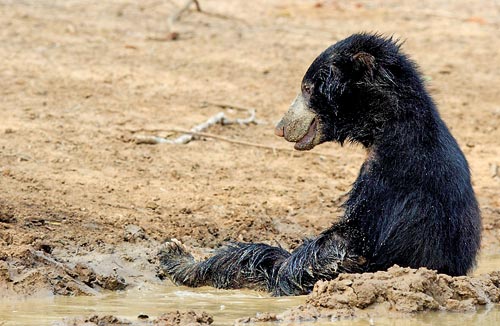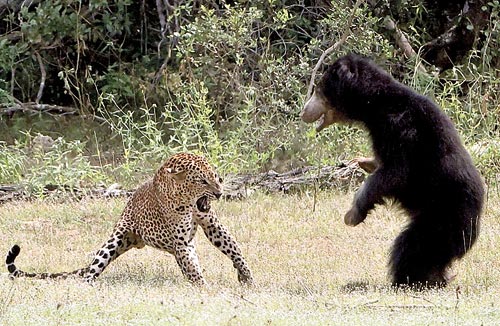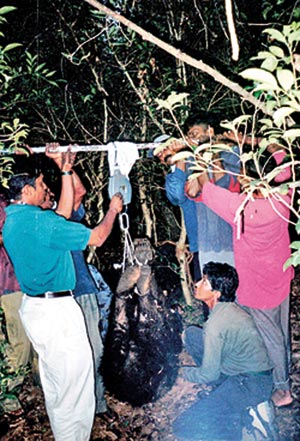Baring her bear fascination

This sloth bear at the Yala National Park seems to be “wallowing” in the mud. Pic by Riaz Cader
It is feared by one and all……..but for ecologist Dr. Shyamala Ratnayeke it is a fascinating creature and she is a staunch believer that sloth bears, the only bear species found in Sri Lanka, are “a unique national treasure!”
For Dr. Ratnayeke who has wide experience as a scientist in many fields which include algae, snails, fireflies, coatis, raccoons and toque macaques, the bear seems to have a special place in her heart.
“Most bears are perceived as charismatic and emblematic of positive human values……strength, power, wilderness and wisdom. Think of Baloo in Rudyard Kipling’s ‘The Jungle Book’. How many teddy bears do you think are sold around the world? A lot! Those warm and positive perceptions though were rare among rural people who lived close to sloth bears when I was in Sri Lanka in the early 2000s,” she points out.
The reassurance, however, was that there was a culture of tolerance for dangerous animals among most rural people or else there would be no sloth bears left in Sri Lanka, she says, reiterating that fear of bears was widespread.
When asked about ‘close encounters’, Dr. Ratnayeke says she did have some at Wasgamuwa – in most instances, the bear ran off grunting in alarm.

A sloth bear-leopard confrontation at the Wilpattu National Park, a rare photo captured by Kithsiri Gunawardena
She says that they often approached bears fitted with radio-transmitters to see where they were resting. “We did this very carefully, or at least we tried to. We got dangerously close to a sleeping female and cub at one time…..less than a metre between the bear and three of us. We could see the hairs on her stomach move up and down as she breathed. We backed off and climbed trees about 25m from the bear.”
To their amazement, both mother and cub slept through all this. The humans waited for over half an hour, after which the duo had woken up and wandered off nonchalantly.
Two other encounters were not that pleasant – “We were charged by adult male bears with loud vocalisations that sounded like deep-throated barks. Both charges were followed by the bear veering off and running away, possibly because we were in a small group of four.”
“Quite frightening,” was the experience, she says.
Not just in Sri Lanka has
Dr. Ratnayeke come into close
contact with bears. Others have been such contact during capture, which she does not think “counts” as a close encounter.

Dr. Shyamala Ratnayeke during field work at Wasgamuwa with her field assistant, Rohan Pieris; Wildlife Officer Karunaratne and veterinarian of the Department of Wildlife Conservation (DWC), Dr. Vijitha Perera
However, one memorable encounter had been with a female black bear which was raiding the trash at a campsite in the Okefenokee National Park in the United States of America (USA). Her husband, Dave Brandenburg, whom she considers the “best field biologist I have yet to meet”, had sought her help in snaring the bear and moving it. But the bear had kept tripping the snare without getting caught, while Dave kept trying to reset it with her help, all this accompanied by the bear huffing and bluff-charging because the snare was next to the big garbage bin she was wanting to raid.
“It was all I could do to not run away screaming. Defensive aggression in black bears is intimidating, but not as common as in sloth bears. Sometimes, though, these black bears make predatory attacks on people, with fatal results. Predatory attacks by sloth bears are extremely rare,” says Dr. Ratnayeke.
Before ‘profiling’ Sri Lanka’s sloth bear, Dr. Ratnayeke says that the first specimen of a sloth bear that reached the British Museum was mistakenly identified as a ‘true’ sloth and named Bradypus ursinus or bear-like sloth. Its name was later modified to reflect that it was a bear, a sloth-like bear. Superficially, sloth bears look somewhat sloth-like: long shaggy coats, long claws and missing incisors, characteristics they share with true sloths. Sloth bears love honey, which may have something to do with the name Melursus, while the family ‘Ursidae’ is a small evolutionary lineage consisting of eight species of bear – India having four kinds of bear, more species than any other country, and Sri Lanka just one species.
Putting the sloth bear under the spotlight, Dr. Ratnayeke says that they are found in suitable habitat through most of the Indian subcontinent. Sri Lanka’s sloth bear, Melursus ursinus inornatus, is recognized as a sub-species unique to the country. Its distribution is limited to the lowlands of the north, east and southeastern areas.
“Here, sloth bears occur in areas that are well-forested, where human densities are low and where human infrastructure such as roads are few,” she explains.
For their size, sloth bears have relatively small home ranges, a characteristic that is shared by animals that eat a lot of termites. In Sri Lanka, fruit tends to be abundant during drier periods and dominates the diet, but termites remain a staple throughout the year. Except for an estimate of sloth bear population size in Nepal’s Chitwan National Park in the 1990s, no reliable population estimates exist throughout their distribution range, laments Dr. Ratnayeke, pointing out that estimated numbers are predominantly hypotheses at this time.

Dr. Shyamala Ratnayeke
She goes onto explain that because sloth bears tend to occur where other carnivores of conservation concern also occur, they serve as valuable ‘conservation surrogates’ and may play crucial roles in sustaining ecological communities in monsoon forests.
When asked about the challenges faced by this creature, she says that the “most severe threat” is potentially habitat alteration and mortality (death) from human-bear conflicts. Future reductions in bear range may result from the combined effects of forest loss and increasing density of humans and roads. Conservation efforts for sloth bears cannot succeed independent of human welfare in the long term; thus, generous social assistance programmes and policies that connect rural people to productive employment opportunities would reduce human pressure on forests and foster peace in post-civil war regions.
Conservation outreach that discusses potential ecological values of sloth bears and ways to reduce human-sloth bear encounters will help people and bears, it is learnt. Her team’s data show that people travelling in groups experience less injury from sloth bear attacks than individuals.
As to why she has a passion for bears, the explanation is simple. It seems like a guru-gola (teacher-student) enthusiasm. During Dr. Ratnayeke’s doctorate on the mid-size carnivore, the North American raccoon, she had worked with Prof. Mike Pelton who had a long-term research programme on American black bears.
“Interestingly, Mike had worked on mice for his doctorate, while at that time, I was much more interested in the smaller carnivores. Nevertheless, I learned a lot about bear research and bear biology from Mike as well as his large crew of graduate students,” she says.
Then came a family connection when she married Dave, one of Mike’s graduates …. and Dave coordinated many of the black bear projects in the southeastern wetlands of the US.
“I picked up lots of useful insights and tips on capture and telemetry in the field. Most of all, I learned that persistence, perseverance and a strong work ethic is crucial to pull off projects of this kind,” says Dr. Ratnayeke, underscoring that the theory and methodologies around carnivore research can apply to multiple species.
| Shedding light on the sun bear | |
| An expert climber, with strong powerful claws which can rip open tree trunks and a long tongue to reach deep into the nests of stingless bees to relish calorie-dense honey and larvae, is the introduction Dr. Shyamala Ratnayeke gives to the exotic-sounding, very secretive, ‘sun bear’, the smallest of the world’s bears.“Sun bears rarely attack people, which may be related, in part, to their very arboreal nature. Rainforest trees afford safe refuge from most predators, so the evolution of aggressive behaviour may not have been necessary,” she explains, adding that they inhabit the warm and humid rain forests of Southeast Asia. |
| All about the Sloth Bear: WNPS lecture | |
| The monthly lecture of the Wildlife and Nature Protection Society (WNPS) on ‘The Sloth Bear in Sri Lanka: Ecology, Conservation & Human Dimensions’ will be delivered by Dr. Shyamala Ratnayeke on July 20 at 6 p.m. at the Jasmine Hall, BMICH, Colombo. |
Searching for an ideal partner? Find your soul mate on Hitad.lk, Sri Lanka's favourite marriage proposals page. With Hitad.lk matrimonial advertisements you have access to thousands of ads from potential suitors who are looking for someone just like you.


